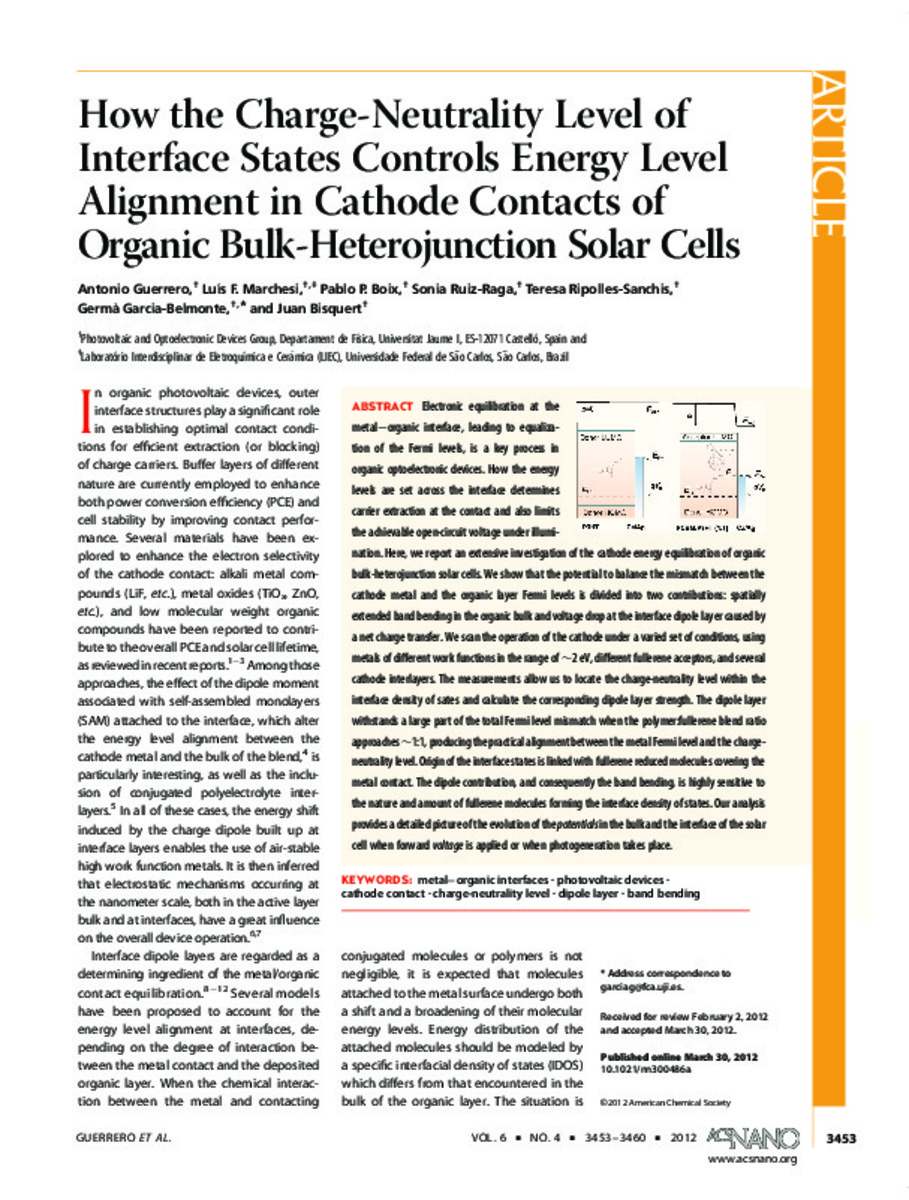Mostrar el registro sencillo del ítem
How the Charge-Neutrality Level of Interface States Controls Energy Level Alignment in Cathode Contacts of Organic Bulk-Heterojunction Solar Cells
| dc.contributor.author | Garcia-Belmonte, Germà | |
| dc.contributor.author | Bisquert, Juan | |
| dc.contributor.author | Guerrero, Antonio | |
| dc.contributor.author | Ripollés Sanchis, Teresa | |
| dc.contributor.author | Marchesi, Luis F. | |
| dc.contributor.author | Boix, Pablo P | |
| dc.contributor.author | Ruiz Raga, Sonia | |
| dc.date.accessioned | 2013-06-05T10:11:45Z | |
| dc.date.available | 2013-06-05T10:11:45Z | |
| dc.date.issued | 2012-04 | |
| dc.identifier.uri | http://hdl.handle.net/10234/65935 | |
| dc.description.abstract | Electronic equilibration at the metal–organic interface, leading to equalization of the Fermi levels, is a key process in organic optoelectronic devices. How the energy levels are set across the interface determines carrier extraction at the contact and also limits the achievable open-circuit voltage under illumination. Here, we report an extensive investigation of the cathode energy equilibration of organic bulk-heterojunction solar cells. We show that the potential to balance the mismatch between the cathode metal and the organic layer Fermi levels is divided into two contributions: spatially extended band bending in the organic bulk and voltage drop at the interface dipole layer caused by a net charge transfer. We scan the operation of the cathode under a varied set of conditions, using metals of different work functions in the range of 2 eV, different fullerene acceptors, and several cathode interlayers. The measurements allow us to locate the charge-neutrality level within the interface density of sates and calculate the corresponding dipole layer strength. The dipole layer withstands a large part of the total Fermi level mismatch when the polymer:fullerene blend ratio approaches 1:1, producing the practical alignment between the metal Fermi level and the charge-neutrality level. Origin of the interface states is linked with fullerene reduced molecules covering the metal contact. The dipole contribution, and consequently the band bending, is highly sensitive to the nature and amount of fullerene molecules forming the interface density of states. Our analysis provides a detailed picture of the evolution of the potentials in the bulk and the interface of the solar cell when forward voltage is applied or when photogeneration takes place. | ca_CA |
| dc.format.extent | 8 p. | ca_CA |
| dc.format.mimetype | application/pdf | ca_CA |
| dc.language.iso | eng | ca_CA |
| dc.publisher | American Chemical Society | ca_CA |
| dc.relation.isPartOf | ACS Nano, v. 6, n. 4 (2012) | ca_CA |
| dc.rights.uri | http://rightsstatements.org/vocab/CNE/1.0/ | * |
| dc.subject | metal−organic interfaces | ca_CA |
| dc.subject | photovoltaic devices | ca_CA |
| dc.subject | cathode contact | ca_CA |
| dc.subject | charge-neutrality level | ca_CA |
| dc.subject | dipole layer | ca_CA |
| dc.subject | band bending | ca_CA |
| dc.title | How the Charge-Neutrality Level of Interface States Controls Energy Level Alignment in Cathode Contacts of Organic Bulk-Heterojunction Solar Cells | ca_CA |
| dc.type | info:eu-repo/semantics/article | ca_CA |
| dc.identifier.doi | http://dx.doi.org/10.1021/nn300486a | |
| dc.rights.accessRights | info:eu-repo/semantics/openAccess | ca_CA |
| dc.type.version | info:eu-repo/semantics/acceptedVersion |
Ficheros en el ítem
Este ítem aparece en la(s) siguiente(s) colección(ones)
-
FCA_Articles [507]
Articles de publicacions periódiques







